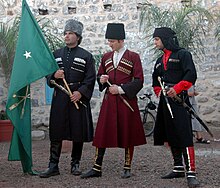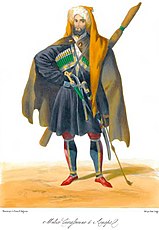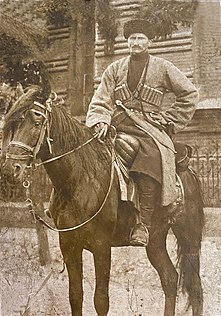Chokha
A chokha[a] also known as the cherkeska[2] is a woolen coat with a high neck that is part of the traditional male dress of peoples of the Caucasus.[3] It was in wide use among Abazins, Abkhazians, Azerbaijanis, Balkars, Chechens, Circassians, Georgians, Ingush, Karachais, Nogais, Ossetians, the peoples of Dagestan, as well as Terek and Kuban Cossacks who adopted it from the aforementioned peoples.
Etymology[]
The word chokha is of Iranian origin meaning 'outfit made of textile'. Russians and Ukrainians called it a cherkeska (meaning 'of/from Circassia') because when they arrived in the Caucasus they saw it for the first time being worn by Circassians. Later the Kuban Cossacks adopted it as part of their costume. In Circassian languages, the chokha is known as shwakh-tsia which means 'covers the horseman', or simply tsia, meaning 'from fabric', and fasha, which means 'fits you', and among Georgians the clothing is also known as talavari.
History and Development[]

A popular theory is that the caftan found in Moschevaya Balka is the protoype of what we know today as chokha.[4] The prototype may have been a common type of clothing among the Khazars and the Alans.[5] It is possible that the chokha has its origins from the Generic Horse Archer Costume which is a clothing style worn by horsemen among the Iranian groups, Western Turks, the Huns, and also the east Germanic peoples who settled in the Pontic and Danube regions and took the clothes west after the invasion of the Huns in 375CE.

There is very little evidence for the existence of a separate women’s clothing across the Eurasian steppe and in the Caucasus since the Moschevaya Balka graves show distinct sexual dimorphism in the clothes. Sogdian and Hunnic Women wore clothing comparatively more similar to their male counterparts. The differences in fashion between men and women start to become more obvious in later centuries, the male attire continues to follow Persian and Central Asian traditions while the female attire seems to have taken some of its inspiration from eastern Mediterranean models but the steppe influence remains.[6]
The caftan was worn by horsemen along the Silk Road in the North Caucasus during the 8th–10th centuries, although, the generic horse archer costume remained basically unchanged in the region for centuries.[7] The costume consisted of the following elements: shorts, leggings, caftan or coat (multiple layers), and boots. The large dolman sleeves allow for freedom of movement and the two slits towards the back allow the skirt to cover the legs more fully while seated on horseback. The original use of the coat is very specialized for mounted archery, horse riding, and combat, similar to the use modern chokha. By the period of the Western Han dynasty (206 BCE– 8 CE), silk trimming became a regular feature in the steppe environment. Prior to this, garments were trimmed with woven trim or fur. Piping or trimming of the caftan's collar and the chest was a common feature among the noble and common classes of the Parthians, Kushans, Sasanians, Sogdians, Hephthalites, Huns, Turks, Alans, Scythians and Khazars. Another design of the caftan also includes the lapels. Lapels do not feature on Parthian, Kushan, or Sasanian caftans, however they do appear in art from Hepthalite and Sogdian sites, it is suggested that the political ascendance of the Western Turks in the Alan’s territory resulted in the adoption of lapels.[8][9] The caftan prevailed in fashion through the early medieval period in the Near East and Central Asia.[10]
The 8th century caftan known as chokha evidently does not resemble the military outfit worn in Caucasus and among Cossacks that we know today. For example, earlier on there was no such detail on the chokha like the gazyr. It appeared later when guns started to be widely used. Initially, gazyrs were carried in leather bags attached to a shoulder strap or belt but a lot of different objects were already attached to the belt, a shashka and a gun were worn over the shoulder on belts. This is also why the gazyrs began to be sewn on the coat on both sides of the chest. This detail helped soldiers to easily store cartridges. In addition, the location it was sewn made it comfortable for the soldier wearing it so during the battle they did not have to look for them and fiddle around for a long time. Some chokhas had removable gazyrs while others were sown on the chest of the coat. Another difference between the prototype and the current chokha is the open cut chest of the coat which was most likely a style brought to Near East as a result of numerous Turkic invasions. The Caucasians also adopted numerous headwear and clothing items from the Turks that started to be worn together with the chokha. By the 18th century, a male costume common for the Caucasus was finally formed which consisted of gazyrs on the chest, beshmet, chokha, burka, bashlyk, papakha, etc.[11]
Revival[]


The chokha was in wide use among the inhabitants of the Caucasus from 8th until the early 20th century, when it declined during the Soviet Era.[12] Nowadays, chokha is no longer in use but continues to still be worn for ceremonial and festive occasions. In Georgia it is used as a symbol of national pride, and is frequently worn by Georgian men at weddings and official functions.[13] Former Georgian President Mikheil Saakashvili ordered high-ranking Georgian officials working abroad to present themselves in national costumes, including the chokha, at official meetings.[14] On June 9, 2020, the National Agency for Cultural Heritage Preservation in Georgia recognized Chokha wearing tradition as a part of Intangible cultural heritage of Georgia.[15]
Types[]
There are two types of chokhas worn most commonly in Caucasus, general and weighted chokha. The common features are that the collars of both chokhas are cut open and the skirt of the coats are usually either corrugated or pleated. Chokha is usually made of broadcloth or shawl but some chokhas are made of thinner textiles for festive occasions. It was also common for chokhas to be worn without the bullet pockets or gazyrs. Sometimes a jacket called arkhalig was worn under chokha. The decorations and patterns on chokha varies among ethnicities. Weapons such as khanjali and shashka are worn alongside the outfit.
General chokha[]
This is the most widely used type of chokha in Caucasus, it has black leather belts decorated with silver pieces. The general chokha were sewn not only from gray and black fabric, but also from red, blue, green, golden yellow, purple and brown. It is cut at the waist with gathers and folds, girded with a narrow belt, the belt buckle served as a chair for carving fire. The outfit was a clothing for combat, it was not supposed to hinder movement, so the sleeves were wide and short, and only the old people made the sleeves long - to warm the hands. As mentioned previously, later on cases were added to place bullets, the bullet cases made it possible to load a flint or match gun at full gallop. Sometimes the cases were located almost under the armpits, dry splinters were also kept for kindling. After the appearance of guns it was also possible to fire the charge of gun powder with a primer. Generally, the chokha outfit includes a khanjali dagger, a beshmet[16] worn under the chokha, gazyrs (bullet/charge holders), and a bashlyk (a hood, separate from the robe) or a papakha (a tall fur hat). The lining of the sleeve of the general chokha is made of silk fabric. These sleeves often have loops and buttons made of string.

Circassian from Anapa. (artist - Gagarin GG)

Kabardian. (artist - Gagarin GG)
Weighted chokha[]
The arms of the weighted chokha are cut straight and long, and weighted gazyrs are built on the coat's chest. Weights adorned with silver or gold are placed with the gazyrs. The length of the weighted chokha varies: some are slightly below the knee, and some are up to the knee. The bullet cases are decorated with various golden or silver laces and other fabrics.

Georgian prince from Imeretia. (artist - Gagarin GG)

A Tatar Bek (Azeri)[17] from Karabakh. (artist - Gagarin GG)
Among Georgians, three types of chokhas are primarily used: the Kartl-Kakheti chokha (Kartli and Kakheti are eastern Georgian provinces), the Khevsur chokha (mainly in the Mtskheta-Mtianeti province of Georgia), and the Adjarian chokha (mainly found in western Georgian provinces such as Adjara and Guria, previously also in Lazona). Special decorations, in addition to the chokha, were adopted by the Order of Chokhosani, who represent an elite cadre of generals, war heroes and famous poets.
Kartli-Kakheti chokha[]
The Kartli-Kakheti version shares similarities with the general Caucasian chokha. In most cases, different decorations fill the bullet spaces. The Kartli-Kakheti chokha is longer than the Khevsur chokha and has triangle-like shapes on the chest, exposing the inner cloth called beshmet. It tends to have gazyrs (locally called masri) on both sides of the chest-spaces. The skirt usually has slits on the sides. People wear them without belts. The Kartli-Kakheti chokha has long sleeves and is usually black, dark red or blue.
This is the most popular chokha used in Georgia, often seen in official meeting and musical performance.
Khevsurian chokha[]

The Khevsur chokha was worn in the Khevsureti province of Georgia in the Greater Caucasus mountains. The Khevsur chokha is considered to be the closest to the medieval version of the chokha as it shares similarities in design with the aforementioned caftan found in Moschevaya Balka. It is mostly short, with trapezoid shapes. The front side of the chokha has rich decorations and slits on the sides, which extend to the waist. The Khevsur chokha has rich decorations made up of crosses and icons.
Adjarian chokha[]

The Adjarian chokha is worn in Adjara, Guria regions of Georgia and was worn in historical Lazeti(modern day Turkey), though, the outfit is more similar to the clothing worn by Pontic Greeks. Adjaran national men's costume consists of a shirt (perangi) and trousers cut out in a specific way (dzigva) and sewn from wool fabric or sateen of black colour. Because trousers are folded, wide on top and narrowed down, they were comfortable and were easy to wear in action. The outer garment was zubuni that was tucked into the trousers. Zubunis were winter clothing, warmed with cotton lining and sleeveless vests. The most expensive and visible part is chokha which was tied around with special broad belt with laces or leather belt. Kabalakhi (or bashlyk) is a winter headwear made of thin wool. And, of course, outfit would not be complete without a dagger in sheath, a rifle and bandolier or gazyr. As footwear they used colorful wool knitted socks, pachula (soft leather shoes) and boots tied with belts.[18]
References[]
| Wikimedia Commons has media related to Chokha. |
- ^ Азербайджанская национальная одежда [Azerbaijani national garments] (in Russian). Azclub.ru. Archived from the original on 2007-03-21. Retrieved 16 April 2013.
- ^ "ЧЕРКЕ́СКА". Большая российская энциклопедия.
- ^ McGuinness, Damien (10 July 2011). "Close-Up: Why Georgia's national costume is back in vogue". BBC.com. Retrieved 15 April 2018.
- ^ "Kaftan ca. 7th–9th century A.D." The Metropolitan Museum of Art.
- ^ "A man's caftan and leggings from the North Caucasus of the eighth to tenth century : a conservator's report / Nobuko Kajitani". The Metropolitan Museum of Art.
- ^ Knauer (2001), p. 133
- ^ Knauer (2001), p. 8
- ^ "Early Turks: Male Costume in the Chinese Art Second half of the 6th – first half of the 8th cc. (Images of 'Others')". Transoxiana.org.
- ^ Knauer (2001), p. 137
- ^ Knauer, Elfriede R. (2001). "A Man's Caftan and Leggings from the North Caucasus of the Eighth to Tenth Century: A Genealogical Study". Metropolitan Museum Journal. The University of Chicago Press. 36: 125–154. doi:10.2307/1513059. JSTOR 1513059.
- ^ "Why did Cossacks & Caucasusian people need THESE? (PHOTOS)". Russia Beyond.
- ^ Satenstein, Liana (May 5, 2017). "What Is Georgia's Traditional Chokha and Why Is It in Fashion?". Vogue.
- ^ "Georgia: Love Your Country, Love Your Chokha". EurasiaNet.org. 2011-02-20. Retrieved 2013-04-16.
- ^ "GeorgianDaily Forum". georgiandaily.com.
- ^ "კულტურული მემკვიდრეობის თ���ალსაზრისით ღირებული ობიექტებისთვის არამატერიალური კულტურული მემკვიდრეობის ძეგლის სტატუსის მინიჭების შესახებ". www.matsne.gov.ge. Legislative Herald of Georgia. Retrieved 5 August 2021.
- ^ "БЕШМЕ́Т". Большая российская энциклопедия.
- ^ In the original, the drawing is called "Bek-Tatar from Karabakh" ({ {lang-fr | Beck Tatare du Karabakhe}}). It is known that in the 19th century Russian travelers also called Azerbaijanis Tatars
- ^ "Adjaran clothing". Advantour.
- ^ Georgian: ჩოხა chokha or ტალავარი t'alavari; Abkhazian: акәымжәы, romanized: akʷymzhʷy; Adyghe: цые, romanized: tsiya; Persian: چوقا, romanized: chughā; Armenian: չուխայ, romanized: choukha(y); Azerbaijani: çuxa;[1] Chechen: чокхиб, romanized: ҫoqib; Kabardian: цей, romanized: tsei; Lezgian: чуха, romanized: chukha; Ossetian: цухъхъа, romanized: cuqqa; Russian: черкеска, romanized: cherkeska; Ukrainian: черкеска, romanized: cherkeska
External links[]
- 9th-century fashion
- Culture of the Caucasus
- Clothing of Georgia (country)
- Persian words and phrases
- Khazars
- Alans
- Circassians
- Cossack culture
- Military uniforms
- Azerbaijani clothing










